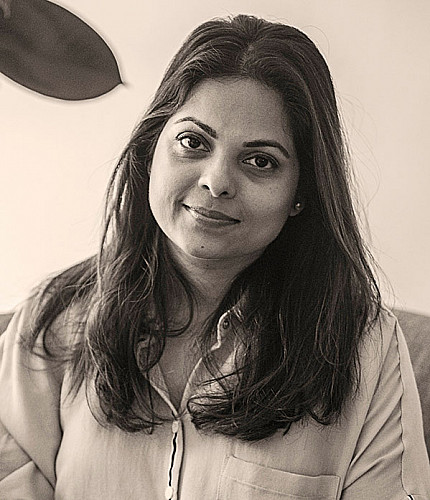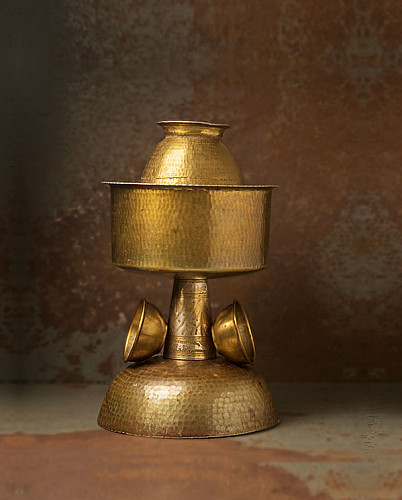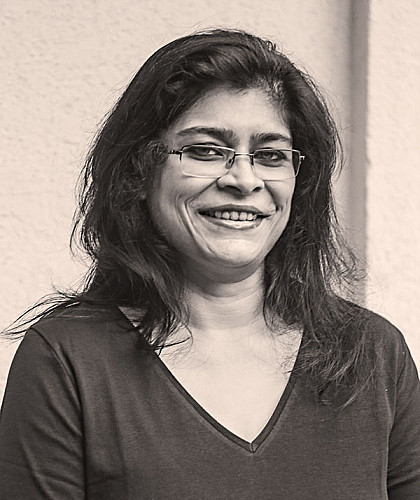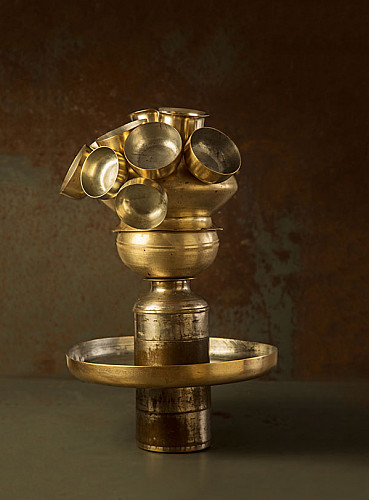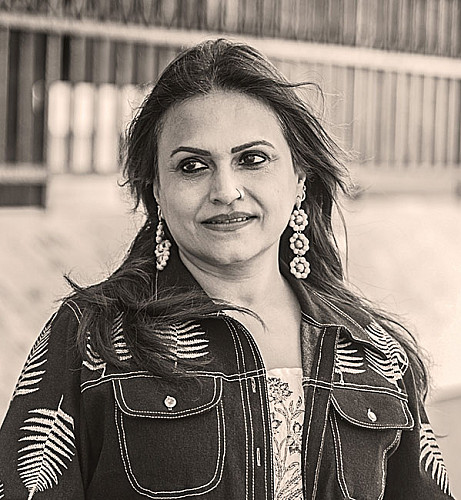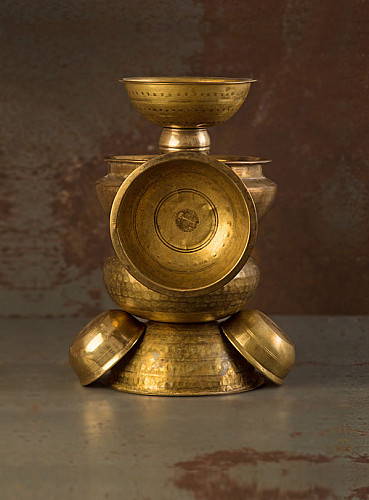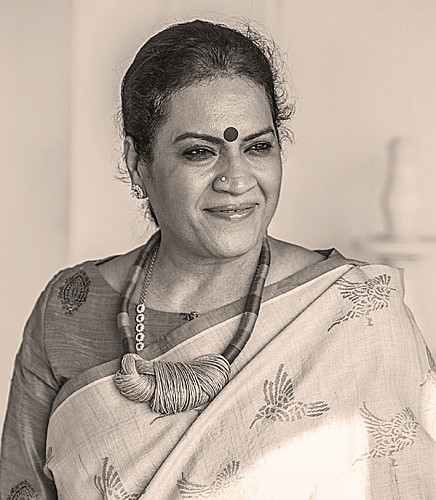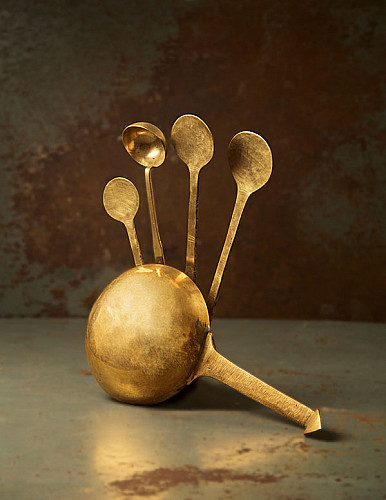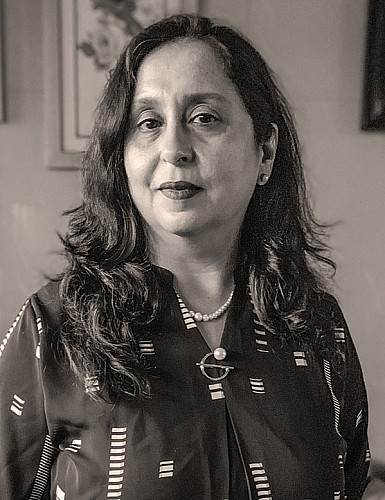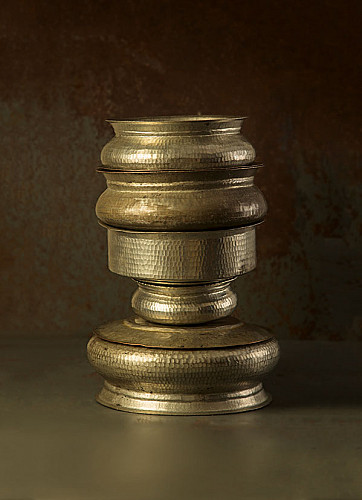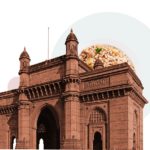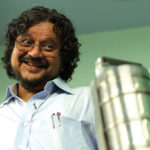- Home
- People
- Verve People
- A Tale of Five Kitchens
A Tale of Five Kitchens
Each of these women owns a trove of traditional metal cooking utensils that have been caringly passed down the generations. Pratibha Tike, Rushina Munshaw Ghildiyal, Ananya Banerjee, Suguna Srikrishnan and Mahrukh Mogrelia put them to good use, regularly hosting a diverse range of meals in their homes through Authenticook, a digital platform that connects chefs with guests looking to sample non-mainstream Indian cuisines. In an exclusive photoessay, Verve highlights the country’s prolific culinary heritage…
PRATIBHA TIKE,
Specialises In Kolhapuri Cuisine
“These utensils have been used for generations — first by my grandmother, then my mother and now me. This particular big bowl with the small mouth is used to store milk or water. And in the pital ka kadhai (a metallic frying vessel), my mum would make sheera (sweet dish) on most weekends for the entire family.”
“Every time I see these utensils, it takes me back to my village holiday. I go back to my childhood and remember my grandparents’ house. The big pital bowl — I remember my grandmother used to keep milk in it. Sometimes, she drank buffalo milk in this glass, which is a combination of pital and brass.”
“All the traditional regional recipes have been passed down from my mom to me. I’m not even thinking of changing the authenticity of these recipes. Because if you change the ingredients or technique, you spoil the real taste. And like my mother, I love making prasad ka sheera in the kadhai and misal (spicy sprout curry) in the big pot.”
RUSHINA MUNSHAW GHILDIYAL,
Specialises In Garhwali And Kutchi-Bhatia Cuisines
“I chose these particular utensils because each one has a piece of my culinary history attached to it. The thali and bowls are from my nani’s kitchen in Lonavla. My grandfather had, many years ago, bought that house from the Nawab of Lonavla, and my nani, my mom and her sisters went there every summer. It had a beautiful traditional-style kitchen with all of the copper utensils, and everything was large-scale. There were 50 of these thalis…. My grandmother was one of the most amazing cooks and kitchen managers. She had the ability to cook for many people at the same time, and yet make sure each of them felt special. When the Lonavla house was being dismantled, a whole bunch of these vessels and kitchen things were sold off. I managed to save this thali as a memory of those days. I use it at all my Indian food events to serve food. I feel like she is smiling down at me!”
“A bhaddu is a traditional cooking utensil from the Garhwal region. These are a legacy from my husband’s grandmother. It’s typically made of an alloy of copper and bronze and is quite solid and heavy. The brass adds a special flavour to foods cooked in it, and the narrow neck traps it within the vessel. Dal or mutton curry cooked slowly on a wood fire in a bhaddu tastes very different! After the advent of the pressure cooker, these are no longer used in mainstream cooking. The third thing in this collection is a tiffin box, and it has sentimental value. The difference in this tiffin is that the top level has a unique lota which is covered. So you could carry food and water or whatever you want to drink in that lota….”
“A lot of the recipes in my pop-ups and in the book I’m writing have been passed down in the family. I have learned them by watching them being cooked by various women: mausis, nanis, dadis, chachis and, of course, my mother-in-law. Sometimes, I try to tweak recipes; for example, the kafuli — a dish of greens — is kind of like the Garhwali version of saag (we make it with pahadi palak). Traditionally, it is cooked with rice flour, but the first recipe I learnt used besan (chickpea flour) and tomatoes in it. I later realised that the traditional recipe actually used rice, so I went back to that because the flavours of the greens come through much better like that. My favourite dish to prepare is my father-in-law’s recipe of meat bhaat (mutton curry). I call it papawalli mutton curry.”
“Hands down, my most memorable experiences are of the Garhwali pop-ups that I have done. They have been most gratifying because I am a Gujarati married into a Garhwali family, and whenever I cook for a Garhwali, I feel the element of imposter syndrome, like I might not have done something right. But every time at my pop-up (where 2-3 Garhwali people generally sign up), they always come back to tell me that it was amazing….”
ANANYA BANERJEE,
Specialises In Bengali And Odia Cuisines
“I’ve picked utensils I’ve seen my grandmother use. She would use a bhontti, which is a traditional chopper for veggies. It’s the kind where you need to sit on the ground to use it. Although, I use a knife in the kitchen instead. My grandmother used a lot of these big bowls to soak veggies. The urli type of vessels were used to make khichuri bhog (a Bengali variety of khichdi) during pujas; round handis were used to make pulao, and I’ve also seen dal simmering away in these vessels.”
“I remember how my grandmother used to finely chop mocha (banana flower). Even the jhiri jhiri aloo bhaja (Bengali shoestring potato fries) used to be the perfect size. I just can’t replicate that with my mandoline, but it’s an effort to crouch on the ground like that and use the chopper! And my grandmother would do that every day!”
“Having to pick a favourite dish is a tough one. My ultimate comfort food is aloo-bhate with ghee-bhaat (boiled mashed potatoes mixed with ghee or mustard oil, seasoned with salt and green chillies, served with ghee rice). Telebhaja or deep fried vegetable fritters is another favourite of mine that my grandmother used to make.”
“Nearly every one of my Bengali recipes has a story to it, which connects to something my mother or grandmother or mother-in-law taught me, or one I was introduced to by my father or uncle. We’re a food-loving family; I don’t think any Bengali isn’t! With changing times, there have been alterations made to these recipes, mostly for health purposes. But there’s always a difference in the taste — when you alter a recipe. And most traditional recipes generally have a reason for including certain ingredients. So when it comes to those, I try to preserve them and create dishes whose ingredients are readily available and whose flavours elicit a fond memory. But I’m always ready to apply old concepts to come up with new dishes.”
“It’s difficult to pick my most memorable experience of cooking for others. But I often host pop-ups for fellow foodies. We love exploring different cuisines when we meet. So I guess one of my best experiences with food comes from introducing an entirely new cuisine to people’s palates and watching their reactions. It never gets old!”
SUGUNA SRIKRISHNAN,
Specialises In Vegetarian Kerala Cuisine From Palakkad
“These are utensils from two generations and are made from an alloy of metals (bronze and copper) and clay; they retain heat and keep the nutritional value intact. They are generally used for slow cooking of non-acidic foods over a long period of time. A mix of vegetables (in local parlance called koottu curry) and rice gets served using these utensils. This is also the metal preferred by priests for temple or religious feasts.”
“Growing up, I saw my aunts using these utensils while visiting our hometown for vacations. Children were not allowed to touch these, as they can crack if dropped. As a kid, I thought it was made of gold, and that gave me the feeling of royalty. Though, in reality, it is not. Small urlis were my favourite, as my aunts used to serve desserts in those!”
“All recipes have been passed down through generations in my family, and I haven’t attempted to alter them. These are age-old and priceless and are being forgotten with influence from the modern world. I like to maintain the authenticity of every vegetarian Kerala dish to bring out the real taste. Kalan (a yogurt-based dish generally served with rice, it is made of coconut, raw banana or yam), olan (cooked in coconut milk and topped with curry leaves and coconut oil, it is prepared with yellow green pumpkin and black eyed peas), avial (a melange of vegetables cooked with ground coconut and green chillis) and payasam (which has different regional variants: milk, sugar and rice payasam; rice, coconut milk and jaggery payasam; as well as jackfruit, coconut and jaggery payasam, etc) are my favourite dishes to prepare.
“My first and most memorable experience cooking for others was with Authenticook. I hosted guests who’d neither heard the names nor tasted most of the items served in the sadhya, which is a dish that is served on a banana leaf. I narrated the stories behind every dish, which made them more inquisitive about our traditions.”
MAHRUKH MOGRELIA,
Specialises In Parsi Cuisine
”In the old days, brides were given kitchen utensils called pad na vasan. These were pots and pans made out of copper and brass, and were kallied or tinned. Mostly, the pans were wide-mouthed and used in order to make patiyo, which is a gravy or sauce. So these broad-based pans also came about to be known as patiyo. These are all heirlooms passed on from my grandma to my mum and to me. I usually make mutton dishes, as well as other slow-cooked meals in these.”
“Whenever I use these pans, and most often I do, I pray that the food tastes as delicious as what my grandma and mummy made. I also have wonderful memories of all these vessels getting tinned before our new year.”
“My recipes have been gathered over the years from my maternal as well as from my in-laws’ side. I’m lucky to have the best from both families…. I do have to compromise on ingredients as well as on product items as per availability, but making the most of them has always resulted in delicious dishes.”
“Every guest, every foodie and every traveller has an interesting tale. Where there is culture and love for food, the tales become memories, and I could write a book about them….”
AUTHENTICOOK
Aneesh Dhairyawan tells us more about the company, which he co-founded with Priyanka Deshpande and Ameya Deshpande.
Some memorable encounters
Once, we had two bookings for a meal – one by an elderly couple and another by four guys. The boys were from the IITB Chemical Engineering batch of 2014, and it turned out that the elderly gentleman was from the IITB Chemical Engineering batch of 1966. The conversations that followed were remarkable! Another instance was when we did a Bengali-Jewish meal that got mentioned in the papers. The first call I got was from an older gentleman who told me he used to have Jewish people employed in Calcutta, and that his chef was also Jewish. Being vegetarian, he could try only a few of the dishes and loved one in particular. But his chef had passed away 15 years ago, and he hadn’t tasted that dish ever since then! He wanted our home-chef to cook some of it for him. That’s the power of food.
The target audience
We have two kinds of customers — locals and visiting travellers. For travellers, we do a combination of a cooking class with a meal experience, and in some cases we also do market visits. Travellers get a chance to visit an Indian home, and learn how to cook a few dishes. This broadens their horizons about Indian life and culture. Locals usually want to relish the lesser known Indian cuisines that are typically not found in restaurants.
Differentiating the experiences
It is the human element involved. Our diners are treated like guests by the home-chefs. The host talks to diners about the food and the stories associated with it. For our home-chefs, they get to be the ambassadors of their cuisine. It is a win-win situation, getting together two sets of people, one that loves to eat and the other that loves to cook and serve.
Because of the nature of the experiences, the response has been heartening. From someone either being reminded of a meal they had 40 years ago to someone becoming nostalgic about their mum’s cooking — it feels like it is right out of a story book.
And for the foreigners, many have identified the Authenticook experience as the best part of their journey.
— As told to Zaral Shah
Verve Trending
Sorry. No data so far.
us on Facebook to stay updated with the latest trends

